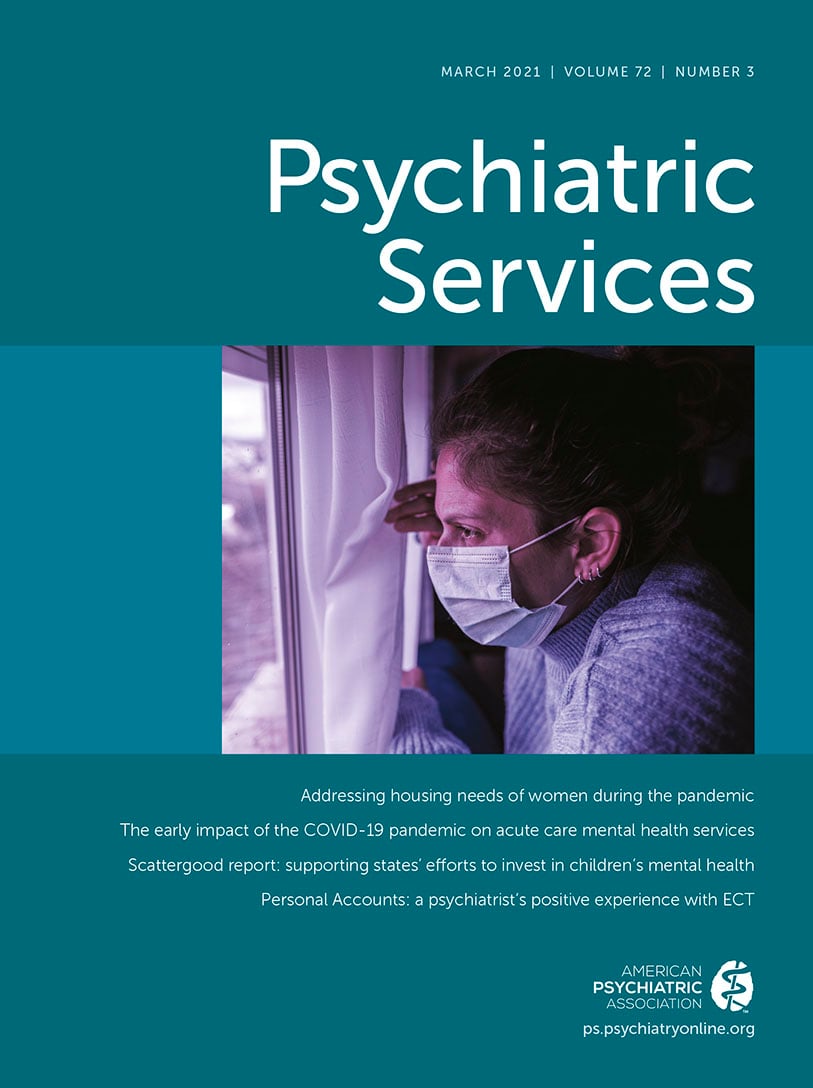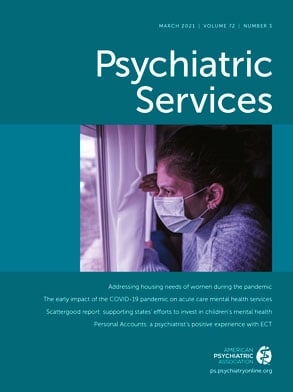The risk for contracting COVID-19 is heightened for individuals experiencing homelessness. For many people living in congregate shelters or street-based encampments, physical distancing and hand-washing guidelines are not feasible. Access to public facilities for maintaining hygiene, such as sinks and toilets, is insufficient in many areas. Distancing may be particularly challenging for families experiencing homelessness, who often “double up” in shared spaces with other families. As cities increase shelter capacity, reports emerge of COVID-19 outbreaks in these settings—including findings that 36% of residents of a Boston shelter tested positive for COVID-19, with most not showing symptoms (
1). These outbreaks suggest that congregate housing, even with the implementation of precautionary measures, may inadequately protect individuals experiencing homelessness against COVID-19.
In addition to an increased infection risk, people experiencing homelessness face widening social and medical inequities in the context of COVID-19. Homelessness is associated with an increased likelihood of psychiatric diagnoses ranging from anxiety to schizophrenia. It is also correlated with poor general medical health and decreased life expectancy. Structural racism has spurred deep racial inequities, with people of color—particularly those who are Black—significantly more likely to experience homelessness and its consequences (
2). As a result of COVID-19, access to usual options for critical services, including mental health and medical clinics, drop-in centers, libraries, food pantries, meal centers, and street outreach, are limited, while police sweeps and harassment continue (
3). Even when services are available, many individuals may hesitate to use them, given the potential exposure risks.
Homelessness, Domestic Violence, and Pregnancy in the COVID-19 Context
Domestic violence (DV) is the leading cause of homelessness for women and a significant risk factor for suicidality, depression, and posttraumatic stress disorder (PTSD) (
4). Among women experiencing DV, homelessness and unstable housing predict worse mental health (
5). DV incidents are widely believed to be on the rise as a result of the COVID-19 pandemic. Sheltering in place results in increased exposure to abusive partners, with fewer options for leaving or safely reporting dangerous situations. Isolation, intimidation, and emotional abuse—tactics often used in DV—are likely to increase under stay-at-home orders, and unemployment and food insecurity may lead to increased use of financial control and coercion. Firearm sales have increased nationwide, and firearms in the home are a well-documented risk factor for homicide in DV situations (
6). Although concerns about DV have increased, shelters in many cities are full, limiting the options for women who need to leave abusive partners.
Pregnant women experiencing homelessness are another particularly vulnerable population. Compared with other women, women experiencing homelessness—including those who are pregnant—are more likely to have experienced childhood abuse, sex and human trafficking, and sexual assault (
7), exposures highly correlated with the development of PTSD, depression, and anxiety. Pregnant women experiencing homelessness face heightened barriers to health care, including prenatal care, mental health services, and substance abuse treatment (
8,
9). This is particularly concerning, given the high risk for worsening of mental health disorders during pregnancy and the postpartum period. Homelessness is associated with poor birth outcomes, including preterm delivery, low birth weight, and neonatal abstinence syndrome (
10). After delivery, new mothers experiencing homelessness must face the very real possibility that their infant will be removed by Child Protective Services, a separation often devastating to the mother’s mental health (
11).
Case Study: Providing Housing to Vulnerable Women in Los Angeles
In Los Angeles County—home to over 42,000 unsheltered individuals, more than in any other U.S. city (
2)—the COVID-19 crisis brought about unprecedented efforts to rapidly house medically vulnerable individuals experiencing homelessness. The multilevel housing effort included expanded capacity through the creation of additional congregate shelters; a pledge to provide 15,000 hotel rooms to people with high-risk medical conditions through California’s “Project Roomkey” interim housing program, which includes meals and case management; and establishment of medical shelters in motor homes/recreational vehicles and motels to provide isolation and medical supervision for individuals with a possible or confirmed COVID-19 infection. This plan to move thousands of individuals off the streets and into supportive housing required an impressive degree of interagency cooperation—particularly notable in Los Angeles’s traditionally siloed health care and social services landscape.
Project Roomkey, although ambitious, initially left out pregnant women experiencing homelessness, as the U.S. Centers for Disease Control and Prevention did not consider pregnancy a high-risk condition relative to COVID-19 infection. In Los Angeles, these women were forced to choose between living in unsheltered conditions or moving into congregate shelters, both of which may feel like dangerous options because of the increased risk for COVID-19 exposure and its potential effects on pregnancy (
12). Additionally, past trauma and current vulnerability can lead pregnant women to feel unsafe in congregate settings. Seeing this gap in coverage, local advocates successfully fought to add pregnant women to the list of high-risk populations eligible for private interim housing through Project Roomkey.
Similar collaborative efforts were needed as DV incidents increased in the context of COVID-19, and women were turned away from already full DV shelters. With the support of a large private donation, the Mayor’s Fund for Los Angeles launched Project Safe Haven to house DV survivors and their children in hotel rooms, with funding for up to 900 families. Like broader emergency housing efforts, this work has required a high degree of interagency collaboration, coordination, and advocacy. Together, numerous agencies provided clients with services (mental health care, food and clothing, children’s educational resources, crisis intervention, legal support, housing security plans, and others) while facilitating provider training and information exchange.
These efforts are not without challenges. Housing is but one social determinant of mental and general medical health affecting these women. How can we rapidly and effectively address pressing mental health, medical, legal, social, and financial needs during a time when in-person contacts have been all but eliminated? Although these programs offer temporary housing regardless of immigration status, how can we ensure permanent housing for women whose immigration status may make housing difficult to obtain? How can the system adapt to the additional needs of women with children? Given the high prevalence of PTSD and other mental health conditions among women experiencing homelessness, how will we effectively and proactively provide mental health and trauma-informed services during this crisis? On a more positive note, how can these initiatives tap into the significant resilience and resourcefulness often demonstrated by women experiencing homelessness? Finally, how will we transition these highly vulnerable women to safe, permanent, supportive housing rather than return them to unsafe living situations, perpetuating the catastrophic cycle of homelessness?
Recommendations
Similarly to the Housing First model for addressing homelessness (
13), the programs described here prioritize rapid provision of housing, including explicit plans to move vulnerable individuals within Project Roomkey to permanent housing. Also, as in Housing First, these programs recognize the role of supportive services beyond housing, which are especially crucial for women with complex mental health and social needs.
Box 1 lists our recommendations for addressing current and anticipated needs based on best practices in women’s health and homelessness services. These recommendations reflect three overarching themes relating to mental health services. First, interagency collaboration is key to ensure access to critical services influencing mental health. Issues of housing, child and family support, DV, and immigration are deeply connected to mental health and must be addressed. Second, agencies should actively lower barriers to mental health care for these women through measures such as universal screening for mental health concerns during housing intake and increased use of telehealth and field-based services. Third, agencies must urgently address gaps in providers’ skills and knowledge about trauma-informed and gender-sensitive care; screening for and addressing DV; and peripartum mental health care, including screening, diagnosis, and medication management.

